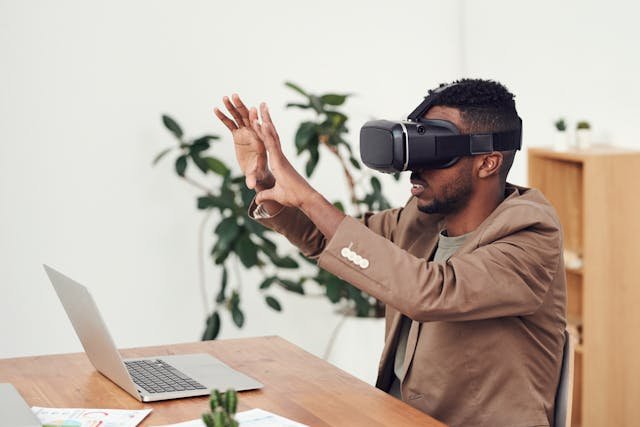Ever used a filter on Instagram or tried Pokémon GO? If so, you’ve already experienced Augmented Reality, or AR. It’s not science fiction — AR is all around us and is becoming part of our everyday lives.
But what exactly is AR, and how does it work? Let’s break it down in a way that’s easy to understand.

🔍 What is Augmented Reality?
Augmented Reality (AR) is a technology that adds digital elements — like images, sounds, or text — to the real world, usually through your phone, tablet, or smart glasses.
Unlike Virtual Reality (VR), which creates a completely digital world, AR enhances your actual environment, blending real and virtual elements together.
Think of AR as a digital layer over the real world.
📱 How Does AR Work?
Here’s how AR works in a simple flow:
- Device Camera: Your phone or tablet captures your surroundings in real time.
- AR Software: The software detects surfaces, faces, or objects.
- Digital Overlay: It adds digital elements — such as animations, graphics, or information — on top of what you see.
It feels like those digital objects are part of the real world, even though they’re not actually there.
🧠 Real-World Examples of AR
You may already be using AR without realizing it! Here are some common examples:
- 🎮 Games: Pokémon GO lets you catch Pokémon that appear in your real surroundings.
- 🛋️ Shopping: IKEA Place shows how furniture looks in your home using your phone camera.
- 📱 Social Media: Instagram and Snapchat filters apply makeup, animal ears, or effects to your face in real time.
- 🚗 Navigation: Google Maps’ Live View uses AR to show arrows and directions as you walk.
- 👨⚕️ Medical Training: AR is used to help doctors visualize organs during surgery.
🔐 Key Features of AR
- Interactive: You can move around and interact with digital objects.
- Real-Time: AR responds instantly to your movements.
- No Headset Needed: Most AR apps work right on your smartphone or tablet.
- Context-Aware: AR can detect surfaces, locations, or objects to adapt what it displays.
🤔 AR vs. VR: What’s the Difference?
| Feature | Augmented Reality (AR) | Virtual Reality (VR) |
|---|---|---|
| Environment | Real world + digital overlay | Fully digital environment |
| Device | Smartphone, tablet, AR glasses | VR headset |
| Interaction | Real-time with surroundings | Only within virtual world |
| Accessibility | Easy to use, no headset needed | Needs special equipment |
🙋 Frequently Asked Questions
Q: Do I need special glasses for AR?
A: Not necessarily. Most AR experiences work on smartphones. However, advanced AR glasses like Microsoft HoloLens offer more immersive experiences.
Q: Is AR only for games and fun apps?
A: No. AR is also used in education, medicine, construction, retail, and more.
Q: Is AR safe to use?
A: Yes, but like any technology, it’s important to use it responsibly — especially when walking or driving.
💭 Final Thoughts
Augmented Reality is transforming the way we see, learn, play, and shop. It bridges the gap between the real and digital worlds, making technology feel more natural and intuitive.
As AR continues to grow, it’s likely to become a major part of our daily lives — not just a fun filter or game, but a tool for education, business, and everyday tasks.
“AR is not just about gaming. It’s about enhancing human experience.”